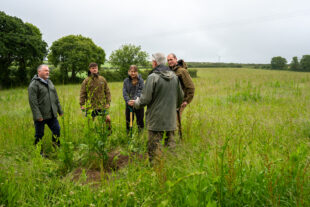https://defrafarming.blog.gov.uk/create-and-maintain-field-corners/
Create and maintain field corners
The guidance on this page is for SFI pilot participants only. Please visit GOV.UK for the official Sustainable Farming Incentive scheme guidance.
Find out how land managers can protect and enhance wildlife habitats and water bodies by creating and maintaining field corners.
If you’re completing this action as part of the Sustainable Farming Incentive pilot, how you do it is up to you.
The advice on this page can help you get better environmental and business benefits, but you do not have to follow it to get paid.
Field corners
Field corners are undisturbed low-input grassy areas of arable or improved grass fields. They are easy to establish and maintain.
You can use field corners to:
- provide nesting sites, food and shelter for wildlife
- protect habitats and water bodies from soil erosion and runoff of sediment, pesticides and nutrients
- can link habitats and allow wildlife to move across the landscape
- reduce pesticide and fertiliser use
- square up cultivated areas to speed up farm operations
Where to put field corners
Field corners can be any shape. They should be no bigger than 2 hectares. You can use field corners that are less productive, or difficult to reach with machinery.
The location may depend on what you want to protect or enhance.
Do not put field corners on historic features, as scrub growth may damage them.
Field corners should not overlap a public right of way.
Wildlife areas
To link with other habitats, choose corners near:
- trees and woodland
- ponds, streams and wet areas
- fallow land
Do not put field corners where there are rare arable wildflowers, as they need cultivation to thrive. Find out how to cultivate fallows for rare arable wildflowers.
Water bodies
Use a soil risk assessment to help you identify where to put field corners to reduce runoff and protect water bodies.
You can use grass strips to prevent runoff of sediment, pesticides and nutrients into water bodies.
Field corners in the base of valleys or across slopes can help reduce runoff and soil erosion.
You must follow the farming rules for water. These require you to take steps to stop manure, fertiliser or soil getting into water bodies.
How to establish field corners in grass fields
To establish a field corner, you should:
- stop grazing the corner
- not apply any nutrients or pesticides
How to establish field corners in arable fields
You can create a field corner by natural regeneration or sowing seeds.
Using natural regeneration means the grasses in the field corner are local to your area. It’s cheaper than sowing a seed mix but takes longer to establish.
You’ll need to sow a seed mix for field corners next to water bodies. A seed mix establishes more quickly and reduces the risk of soil erosion, which can damage freshwater habitats.
When to establish
Autumn is the best time to establish a seed mix. There will be less competition from weeds and more moisture in the soil. You can sow in spring, but you may need to increase the seed rate depending on weather and soil type.
For natural regeneration, cultivate between spring and late summer. Meet GAEC1 rules when cultivating next to water bodies.
Create your seedbed
Create a well-consolidated, firm, fine, level and weed-free seedbed before establishing to improve germination. This is the most effective weed and slug control method.
You should remove any soil compaction.
You can roll seedbeds before sowing if they are uneven after secondary cultivations.
Natural regeneration
Cultivate the soil and let existing seeds germinate.
Sowing a seed mix
Choose a seed mix that contains native grass species. Grass species that will grow in most conditions include:
- timothy
- cocksfoot
- crested dog’s-tail
- red fescue
- smooth-stalked meadow grass
Species like timothy and cocksfoot create tussocky grass. This provides shelter for insects, spiders and small mammals.
Your seed supplier can help you choose a seed mix and seed rate to best match your land and local conditions.
You can add native wildflower seeds to the mix to provide pollen and nectar for invertebrates.
How to establish a seed mix
Scatter or shallow-drill seeds into bare ground.
Seeds germinate best when scattered on the surface. Shallow drill no deeper than 1cm, because small seeds struggle to germinate when sown any deeper.
Roll after sowing to retain moisture and ensure good seed-to-soil contact
Cut field corners regularly in the first 12 to 18 months after sowing. This controls annual weeds and encourages the grasses to tiller.
If you have used natural regeneration it may take longer to control weeds. You may need to continue cutting 3 to 5 times a year for 2 years or more.
How to manage field corners
Field corners do not need much maintenance. You can let tussocky grass and low scrub grow.
Cut or graze field corners once every 5 years at most, to maintain the tussocky grass and low scrub. Cut or graze between 1 September and 28 February, which is outside the bird breeding season.
Do not graze field corners that you’re using in the water body buffering standard.
Cut or graze different field corners in different years. This will allow different ages of vegetation to grow and benefit a variety of wildlife. You can also achieve this by only cutting or grazing part of a field corner.
To avoid compacting the soil and creating bare ground, do not:
- cut or graze when the soil is wet
- use field corners for regular vehicle access, storage or moving livestock
- cut hedges or maintain ditches next to field corners when the soil is wet
You do not need to apply fertiliser or manure.
Cutting
Remove cut vegetation where possible to:
- reduce the risk of it smothering grass species
- remove nutrients, which helps prevent weeds from growing in the field corner
You can leave small amounts of finely chopped cuttings if it’s impractical to remove them. Spread cuttings as thinly as possible. A heavy-duty flail will chop up the vegetation and allow it to rot quicker.
Grazing
Do not allow livestock to:
- graze the grass shorter than an average height of 20cm
- poach and flatten the field corner
- supplementary feed on the field corner
- graze field corners that you’re using in the water body buffering standard
Weed control
To control weeds like docks, nettles, thistles and common ragwort, you can spot treat with herbicide using a knapsack sprayer, hand-lance or weed wiper.
What a good field corner looks like
You’ll see:
- dense, tussocky grass cover
- scattered low scrub
- few or no weeds, like docks, ragwort, thistles or nettles
- little or no bare ground, ruts or poaching
- few or no channels or gullies formed from soil erosion
- more birds, small mammals, insects and amphibians
- cleaner and clearer surface water nearby



